Soil Chemical Properties Depending on Fertilization and Management in China: A Meta-Analysis
Abstract
1. Introduction
2. Materials and Methods
2.1. Data Collection
2.2. Data Analysis Method
2.2.1. Meta-Analysis
2.2.2. Analysis of the Contribution of Explanatory Variables
2.2.3. Statistical Analysis
3. Results
3.1. Effects of Different Fertilizers on the Soil Chemical Properties
3.2. Effects of the Climate Region and Different Fertilizers on the Soil Chemical Properties
3.3. Effects of the Crop and Fertilizer Types on the Soil Chemical Properties
3.4. Effects of the Fertilization Duration and Fertilizer Types on the Soil Chemical Properties
3.5. Effects of the Soil Texture on the Soil Chemical Properties under Fertilizer
3.6. Correlations between the Percentage Change of the Soil Chemical Properties and the Explanatory Variables
4. Discussion
4.1. Dynamics of the Soil Chemical Properties Due to Fertilizer Regimes Depending on Climate and Crop Types
4.2. The Interaction between the Soil Chemical Properties and Yield Depending on Climate and Crops Type
4.3. Soil Texture and Its Modifying Effect on the Dynamics of Soil Chemical Properties over Long-Term Fertilization
4.4. Practical Fertilization Management for Sustainable Agriculture
5. Conclusions
Author Contributions
Funding
Data Availability Statement
Conflicts of Interest
References
- FAO. Fao Databases. 2021. Available online: https://www.fao.org/faostat/en/#home (accessed on 5 June 2022).
- Roberts, T. The Role of Fertilizer in Growing the World’s Food. Better Crops 2009, 93, 12–15. [Google Scholar]
- Erisman, J.W.; Galloway, J.N.; Seitzinger, S.; Bleeker, A.; Dise, N.B.; Petrescu, A.R.; Leach, A.M.; de Vries, W. Consequences of Human Modification of the Global Nitrogen Cycle. Philos. Trans. R. Soc. B Biol. Sci. 2013, 368, 20130116. [Google Scholar] [CrossRef] [PubMed]
- Sánchez, P.A. Tripling Crop Yields in Tropical Africa. Nat. Geosci. 2010, 3, 299–300. [Google Scholar] [CrossRef]
- Liu, E.; Yan, C.; Mei, X.; Zhang, Y.; Fan, T. Long-Term Effect of Manure and Fertilizer on Soil Organic Carbon Pools in Dryland Farming in Northwest China. PLoS ONE 2013, 8, e56536. [Google Scholar] [CrossRef]
- Raza, S.; Miao, N.; Wang, P.; Ju, X.; Chen, Z.; Zhou, J.; Kuzyakov, Y. Dramatic Loss of Inorganic Carbon by Nitrogen-Induced Soil Acidification in Chinese Croplands. Glob. Chang. Biol. 2020, 26, 3738–3751. [Google Scholar] [CrossRef] [PubMed]
- Raza, S.; Zamanian, K.; Ullah, S.; Kuzyakov, Y.; Virto, I.; Zhou, J. Inorganic Carbon Losses by Soil Acidification Jeopardize Global Efforts on Carbon Sequestration and Climate Change Mitigation. J. Clean. Prod. 2021, 315, 128036. [Google Scholar] [CrossRef]
- Kuzyakov, Y.; Kuzyakova, I.; Raza, S.; Zhou, J.; Zamanian, K. To-the-Editor: Does Acidification Really Increase Soil Carbon in Croplands? How Statistical Analyses of Large Datasets Might Mislead the Conclusions. Geoderma 2021, 384, 114806. [Google Scholar] [CrossRef]
- Güsewell, S. N: P Ratios in Terrestrial Plants: Variation and Functional Significance. New Phytol. 2004, 164, 243–266. [Google Scholar] [CrossRef]
- Johnston, A.; Goulding, K.; Poulton, P. Soil Acidification During More Than 100 Years under Permanent Grassland and Woodland at Rothamsted. Soil Use Manag. 1986, 2, 3–10. [Google Scholar] [CrossRef]
- Lucas, R.; Klaminder, J.; Futter, M.; Bishop, K.H.; Egnell, G.; Laudon, H.; Högberg, P. A Meta-Analysis of the Effects of Nitrogen Additions on Base Cations: Implications for Plants, Soils, and Streams. For. Ecol. Manag. 2011, 262, 95–104. [Google Scholar] [CrossRef]
- Tian, D.; Niu, S. A Global Analysis of Soil Acidification Caused by Nitrogen Addition. Environ. Res. Lett. 2015, 10, 024019. [Google Scholar] [CrossRef]
- Guo, J.; Liu, X.; Zhang, Y.; Shen, J.; Han, W.; Zhang, W.; Christie, P.; Goulding, K.; Vitousek, P.; Zhang, F. Significant Acidification in Major Chinese Croplands. Science 2010, 327, 1008–1010. [Google Scholar] [CrossRef] [PubMed]
- Hao, T.; Zhu, Q.; Zeng, M.; Shen, J.; Shi, X.; Liu, X.; Zhang, F.; de Vries, W. Impacts of Nitrogen Fertilizer Type and Application Rate on Soil Acidification Rate under a Wheat-Maize Double Cropping System. J. Environ. Manag. 2020, 270, 110888. [Google Scholar] [CrossRef]
- Lu, X.; Mao, Q.; Gilliam, F.S.; Luo, Y.; Mo, J. Nitrogen Deposition Contributes to Soil Acidification in Tropical Ecosystems. Glob. Change Biol. 2014, 20, 3790–3801. [Google Scholar] [CrossRef]
- Yaduvanshi, N. Substitution of Inorganic Fertilizers by Organic Manures and the Effect on Soil Fertility in a Rice–Wheat Rotation on Reclaimed Sodic Soil in India. J. Agric. Sci. 2003, 140, 161–168. [Google Scholar] [CrossRef]
- Kinraide, T. Toxicity Factors in Acidic Forest Soils: Attempts to Evaluate Separately the Toxic Effects of Excessive Al3+ and H+ and Insufficient Ca2+ and Mg2+ Upon Root Elongation. Eur. J. Soil Sci. 2003, 54, 323–333. [Google Scholar] [CrossRef]
- Zamanian, K.; Zhou, J.; Kuzyakov, Y. Soil Carbonates: The Unaccounted, Irrecoverable Carbon Source. Geoderma 2021, 384, 114817. [Google Scholar] [CrossRef]
- Zamanian, K.; Kuzyakov, Y. Contribution of Soil Inorganic Carbon to Atmospheric Co2: More Important Than Previously Thought. Glob. Chang. Biol. 2019, 25, E1–E3. [Google Scholar] [CrossRef] [PubMed]
- Liu, S.; Wang, J.; Pu, S.; Blagodatskaya, E.; Kuzyakov, Y.; Razavi, B.S. Impact of Manure on Soil Biochemical Properties: A Global Synthesis. Sci. Total Environ. 2020, 745, 141003. [Google Scholar] [CrossRef]
- Ahmed, F.; Islam, M.; Rahman, M.M.; Bhuiyan, M.S.H.; Kader, M. Long Term Manuring and Fertilization Effect on Soil Properties in Terrace Soil. Asian Res. J. Agric. 2020, 13, 44–52. [Google Scholar] [CrossRef]
- Purakayastha, T.; Rudrappa, L.; Singh, D.; Swarup, A.; Bhadraray, S. Long-Term Impact of Fertilizers on Soil Organic Carbon Pools and Sequestration Rates in Maize–Wheat–Cowpea Cropping System. Geoderma 2008, 144, 370–378. [Google Scholar] [CrossRef]
- Powlson, D.; Bhogal, A.; Chambers, B.; Coleman, K.; Macdonald, A.; Goulding, K.; Whitmore, A. The Potential to Increase Soil Carbon Stocks through Reduced Tillage or Organic Material Additions in England and Wales: A Case Study. Agr. Ecosyst. Environ. 2012, 146, 23–33. [Google Scholar] [CrossRef]
- Zhao, X.; Othmanli, H.; Schiller, T.; Zhao, C.; Sheng, Y.; Zia, S.; Müller, J.; Stahr, K. Water Use Efficiency in Saline Soils under Cotton Cultivation in the Tarim River Basin. Water 2015, 7, 3103–3122. [Google Scholar] [CrossRef]
- Lee, S.B.; Lee, C.H.; Jung, K.Y.; Do Park, K.; Lee, D.; Kim, P.J. Changes of Soil Organic Carbon and Its Fractions in Relation to Soil Physical Properties in a Long-Term Fertilized Paddy. Soil Till Res. 2009, 104, 227–232. [Google Scholar] [CrossRef]
- Shen, H.; Cao, Z. Efrect of Long-Term Fertilization on Soil Available Carbon Pool and Available Ratio of Soil Carbon under Different Agroecosystems. Trop. Subtrop. Soil Sci. 1998, 7, 1–5, (In Chinese with English Abstract). [Google Scholar]
- Gong, W.; Yan, X.; Wang, J.; Hu, T.; Gong, Y. Long-Term Manuring and Fertilization Effects on Soil Organic Carbon Pools under a Wheat–Maize Cropping System in North China Plain. Plant Soil 2009, 314, 67–76. [Google Scholar] [CrossRef]
- Hai, L.; Li, X.; Li, F.; Suo, D.; Guggenberger, G. Long-Term Fertilization and Manuring Effects on Physically-Separated Soil Organic Matter Pools under a Wheat–Wheat–Maize Cropping System in an Arid Region of China. Soil Biol. Biochem. 2010, 42, 253–259. [Google Scholar] [CrossRef]
- Lou, Y.; Xu, M.; Wang, W.; Sun, X.; Liang, C. Soil Organic Carbon Fractions and Management Index after 20 Yr of Manure and Fertilizer Application for Greenhouse Vegetables. Soil Use Manag. 2011, 27, 163–169. [Google Scholar] [CrossRef]
- Cai, Z.; Qin, S. Dynamics of Crop Yields and Soil Organic Carbon in a Long-Term Fertilization Experiment in the Huang-Huai-Hai Plain of China. Geoderma 2006, 136, 708–715. [Google Scholar] [CrossRef]
- He, Y.; Zhang, W.; Xu, M.; Tong, X.; Sun, F.; Wang, J.; Huang, S.; Zhu, P.; He, X. Long-Term Combined Chemical and Manure Fertilizations Increase Soil Organic Carbon and Total Nitrogen in Aggregate Fractions at Three Typical Cropland Soils in China. Sci. Total Environ. 2015, 532, 635–644. [Google Scholar] [CrossRef] [PubMed]
- Zhang, W.; Xu, M.; Wang, B.; Wang, X. Soil Organic Carbon, Total Nitrogen and Grain Yields under Long-Term Fertilizations in the Upland Red Soil of Southern China. Nutr. Cycl. Agroecosyst. 2009, 84, 59–69. [Google Scholar] [CrossRef]
- Whalen, J.K.; Chang, C. Phosphorus Accumulation in Cultivated Soils from Long-Term Annual Applications of Cattle Feedlot Manure. J. Environ. Qual. 2001, 30, 229–237. [Google Scholar] [CrossRef] [PubMed]
- He, P.; Yang, L.; Xu, X.; Zhao, S.; Chen, F.; Li, S.; Tu, S.; Jin, J.; Johnston, A.M. Temporal and Spatial Variation of Soil Available Potassium in China (1990–2012). Field Crops Res. 2015, 173, 49–56. [Google Scholar] [CrossRef]
- Song, X.; Liu, F.; Wu, H.; Cao, Q.; Zhong, C.; Yang, J.; Li, D.; Zhao, Y.; Zhang, G. Effects of Long-Term K Fertilization on Soil Available Potassium in East China. Catena 2020, 188, 104412. [Google Scholar] [CrossRef]
- Ding, X.; Wei, C.; Wang, R.; Liao, X.; Li, S. Phosphorus Leaching Risk Assessment with Manure Fertilizer Application in South China. Bull. Environ. Contam. Toxicol. 2014, 93, 120–125. [Google Scholar] [CrossRef]
- Wei, K.; Bao, H.; Huang, S.; Chen, L. Effects of Long-Term Fertilization on Available P, P Composition and Phosphatase Activities in Soil from the Huang-Huai-Hai Plain of China. Agr. Ecosyst. Environ. 2017, 237, 134–142. [Google Scholar] [CrossRef]
- Ren, F.; Misselbrook, T.; Sun, N.; Zhang, X.; Zhang, S.; Jiao, J.; Xu, M.; Wu, L. Spatial Changes and Driving Variables of Topsoil Organic Carbon Stocks in Chinese Croplands under Different Fertilization Strategies. Sci. Total Environ. 2021, 767, 144350. [Google Scholar] [CrossRef]
- Su, Y.; Ma, X.F.; Gong, Y.M.; Li, K.H.; Han, W.X.; Liu, X.J. Responses and Drivers of Leaf Nutrients and Resorption to Nitrogen Enrichment across Northern China’s Grasslands: A Meta-Analysis. Catena 2021, 199, 105110. [Google Scholar] [CrossRef]
- Hedges, L.V.; Gurevitch, J.; Curtis, P.S. The Meta-Analysis of Response Ratios in Experimental Ecology. Ecology 1999, 80, 1150–1156. [Google Scholar] [CrossRef]
- Li, J.; Zou, B.Y.; Yeo, Y.H.; Feng, Y.M.; Xie, X.Y.; Lee, D.H.; Fujii, H.; Wu, Y.K.; Kam, L.Y.; Ji, F.P. Prevalence, Incidence, and Outcome of Non-Alcoholic Fatty Liver Disease in Asia, 1999–2019: A Systematic Review and Meta-Analysis. Lancet Gastroenterol. Hepatol. 2019, 4, 389–398. [Google Scholar] [CrossRef]
- Sha, Z.; Ma, X.; Wang, J.; Lv, T.; Li, Q.; Misselbrook, T.; Liu, X. Effect of N Stabilizers on Fertilizer-N Fate in the Soil-Crop System: A Meta-Analysis. Agr. Ecosyst. Environ. 2020, 290, 106763. [Google Scholar] [CrossRef]
- Barak, P.; Jobe, B.O.; Krueger, A.R.; Peterson, L.A.; Laird, D.A. Effects of Long-Term Soil Acidification Due to Nitrogen Fertilizer Inputs in Wisconsin. Plant Soil 1997, 197, 61–69. [Google Scholar] [CrossRef]
- Cai, Z.; Wang, B.; Xu, M.; Zhang, H.; He, X.; Zhang, L.; Gao, S. Intensified Soil Acidification from Chemical N Fertilization and Prevention by Manure in an 18-Year Field Experiment in the Red Soil of Southern China. J. Soils Sediments 2015, 15, 260–270. [Google Scholar] [CrossRef]
- Schroder, J.L.; Zhang, H.; Girma, K.; Raun, W.R.; Penn, C.J.; Payton, M.E. Soil Acidification from Long-Term Use of Nitrogen Fertilizers on Winter Wheat. Soil Sci. Soc. Am. J. 2011, 75, 957–964. [Google Scholar] [CrossRef]
- Stroia, C.; Morel, C.; Jouany, C. Nitrogen Fertilization Effects on Grassland Soil Acidification: Consequences on Diffusive Phosphorus Ions. Soil Sci. Soc. Am. J. 2011, 75, 112–120. [Google Scholar] [CrossRef]
- Aula, L.; Macnack, N.; Omara, P.; Mullock, J.; Raun, W. Effect of Fertilizer Nitrogen (N) on Soil Organic Carbon, Total N, and Soil Ph in Long-Term Continuous Winter Wheat (Triticum aestivum L.). Commun. Soil Sci. Plant Anal. 2016, 47, 863–874. [Google Scholar] [CrossRef]
- Divito, G.A.; Rozas, H.R.S.; Echeverría, H.E.; Studdert, G.A.; Wyngaard, N. Long Term Nitrogen Fertilization: Soil Property Changes in an Argentinean Pampas Soil under No Tillage. Soil Till. Res. 2011, 114, 117–126. [Google Scholar] [CrossRef]
- Cavallaro, N.; Padilla, N.; Villarrubia, J. Sewage Sludge Effects on Chemical Properties of Acid Soils. Soil Sci. 1993, 156, 63–70. [Google Scholar] [CrossRef]
- Eghball, B. Liming Effects of Beef Cattle Feedlot Manure or Compost. Commun. Soil Sci. Plant Anal. 1999, 30, 2563–2570. [Google Scholar] [CrossRef]
- Huang, S.; Zhang, W.; Yu, X.; Huang, Q. Effects of Long-Term Fertilization on Corn Productivity and Its Sustainability in an Ultisol of Southern China. Agr. Ecosyst. Environ. 2010, 138, 44–50. [Google Scholar] [CrossRef]
- Sun, R.; Zhang, X.; Guo, X.; Wang, D.; Chu, H. Bacterial Diversity in Soils Subjected to Long-Term Chemical Fertilization Can Be More Stably Maintained with the Addition of Livestock Manure Than Wheat Straw. Soil Biol. Biochem. 2015, 88, 9–18. [Google Scholar] [CrossRef]
- Zhong, W.; Gu, T.; Wang, W.; Zhang, B.; Lin, X.; Huang, Q.; Shen, W. The Effects of Mineral Fertilizer and Organic Manure on Soil Microbial Community and Diversity. Plant Soil 2010, 326, 511–522. [Google Scholar] [CrossRef]
- Jugsujinda, A.; Patrick Jr, W. Growth and Nutrient Uptake by Rice in a Flooded Soil under Controlled Aerobic-Anaerobic and Ph Conditions1. Agron. J. 1977, 69, 705–710. [Google Scholar] [CrossRef]
- Yang, Z.; Hu, Y.; Zhang, S.; Raza, S.; Wei, X.; Zhao, X. The Thresholds and Management of Irrigation and Fertilization Earning Yields and Water Use Efficiency in Maize, Wheat, and Rice in China: A Meta-Analysis (1990–2020). Agronomy 2022, 12, 709. [Google Scholar] [CrossRef]
- Dong, X.; Hao, Q.; Li, G.; Lin, Q.; Zhao, X. Contrast Effect of Long-Term Fertilization on Soc and Sic Stocks and Distribution in Different Soil Particle-Size Fractions. J. Soils Sediments 2017, 17, 1054–1063. [Google Scholar] [CrossRef]
- Sleutel, S.; De Neve, S.; Németh, T.; Tóth, T.; Hofman, G. Effect of Manure and Fertilizer Application on the Distribution of Organic Carbon in Different Soil Fractions in Long-Term Field Experiments. Eur. J. Agron. 2006, 25, 280–288. [Google Scholar] [CrossRef]
- Anastasiou, E.; Lorentz, K.O.; Stein, G.J.; Mitchell, P.D. Prehistoric Schistosomiasis Parasite Found in the Middle East. Lancet Infect. Dis. 2014, 14, 553–554. [Google Scholar] [CrossRef]
- Huang, F.; Ding, X.; Li, W.; Jia, H.; Wei, X.; Zhao, X. The Effect of Temperature on the Decomposition of Different Parts of Maize Residues in a Solonchak. Catena 2021, 201, 105207. [Google Scholar] [CrossRef]
- Jastrow, J.D.; Amonette, J.E.; Bailey, V.L. Mechanisms Controlling Soil Carbon Turnover and Their Potential Application for Enhancing Carbon Sequestration. Clim. Chang. 2007, 80, 5–23. [Google Scholar] [CrossRef]
- Zhao, B.; Chen, J.; Zhang, J.; Xin, X.; Hao, X. How Different Long-Term Fertilization Strategies Influence Crop Yield and Soil Properties in a Maize Field in the North China Plain. J. Plant Nutr. Soil Sci. 2013, 176, 99–109. [Google Scholar] [CrossRef]
- Bonanomi, G.; De Filippis, F.; Zotti, M.; Idbella, M.; Cesarano, G.; Al-Rowaily, S.; Abd-ElGawad, A. Repeated Applications of Organic Amendments Promote Beneficial Microbiota, Improve Soil Fertility and Increase Crop Yield. Appl. Soil Ecol. 2020, 156, 103714. [Google Scholar] [CrossRef]
- Van Eekeren, N.; De Boer, H.; Bloem, J.; Schouten, T.; Rutgers, M.; De Goede, R.; Brussaard, L. Soil Biological Quality of Grassland Fertilized with Adjusted Cattle Manure Slurries in Comparison with Organic and Inorganic Fertilizers. Biol. Fertil. Soils 2009, 45, 595–608. [Google Scholar] [CrossRef]
- Chaudhry, V.; Rehman, A.; Mishra, A.; Chauhan, P.S.; Nautiyal, C.S. Changes in Bacterial Community Structure of Agricultural Land Due to Long-Term Organic and Chemical Amendments. Microb. Ecol. 2012, 64, 450–460. [Google Scholar] [CrossRef]
- Liu, Q.; Xu, H.; Yi, H. Impact of Fertilizer on Crop Yield and C:N: P Stoichiometry in Arid and Semi-Arid Soil. Int. J. Environ. Res. Public. Health 2021, 18, 4341. [Google Scholar] [CrossRef]
- Choudhary, M.; Meena, V.S.; Panday, S.C.; Mondal, T.; Yadav, R.P.; Mishra, P.K.; Bisht, J.K.; Pattanayak, A. Long-Term Effects of Organic Manure and Inorganic Fertilization on Biological Soil Quality Indicators of Soybean-Wheat Rotation in the Indian Mid-Himalaya. Appl. Soil Ecol. 2021, 157, 103754. [Google Scholar] [CrossRef]
- Chai, Y.; Ma, S.; Zeng, X.; E, S.; Che, Z.; Li, L.; Duan, R.; Su, S. Long-Term Fertilization Effects on Soil Organic Carbon Stocks in the Irrigated Desert Soil of Nw China. J. Plant Nutr. Soil Sci. 2015, 178, 622–630. [Google Scholar] [CrossRef]
- Kukal, S.; Benbi, D. Soil Organic Carbon Sequestration in Relation to Organic and Inorganic Fertilization in Rice–Wheat and Maize–Wheat Systems. Soil Till. Res. 2009, 102, 87–92. [Google Scholar] [CrossRef]
- Tong, X.; Xu, M.; Wang, X.; Bhattacharyya, R.; Zhang, W.; Cong, R. Long-Term Fertilization Effects on Organic Carbon Fractions in a Red Soil of China. Catena 2014, 113, 251–259. [Google Scholar] [CrossRef]
- Zhao, X.; Hu, K.; Stahr, K. Simulation of Soc Content and Storage under Different Irrigation, Fertilization and Tillage Conditions Using Epic Model in the North China Plain. Soil Till. Res. 2013, 130, 128–135. [Google Scholar] [CrossRef]
- Singh Brar, B.; Singh, J.; Singh, G.; Kaur, G. Effects of Long Term Application of Inorganic and Organic Fertilizers on Soil Organic Carbon and Physical Properties in Maize–Wheat Rotation. Agronomy 2015, 5, 220–238. [Google Scholar] [CrossRef]
- Blair, N.; Faulkner, R.D.; Till, A.R.; Korschens, M.; Schulz, E. Long-Term Management Impacts on Soil C, N and Physical Fertility: Part Ii: Bad Lauchstadt Static and Extreme Fym Experiments. Soil Till. Res. 2006, 91, 39–47. [Google Scholar] [CrossRef]
- Huang, S.; Pan, X.; Guo, J.; Qian, C.; Zhang, W. Differences in Soil Organic Carbon Stocks and Fraction Distributions between Rice Paddies and Upland Cropping Systems in China. J. Soils Sediments 2014, 14, 89–98. [Google Scholar] [CrossRef]
- Li, Y.; Zhang, X.; Ren, F.; Sun, N.; Xu, M.; Xu, M. A Meta-Analysis of Long-Term Fertilization Impact on Soil Dissolved Organic Carbon and Nitrogen across Chinese Cropland Scientia. Agric. Sin. 2020, 53, 224–1233, (In Chinese with English Abstract). [Google Scholar]
- Hu, Y.; Wang, L.; Chen, F.; Ren, X.; Tan, Z. Soil Carbon Sequestration Efficiency under Continuous Paddy Rice Cultivation and Excessive Nitrogen Fertilization in South China. Soil Till. Res. 2021, 213, 105108. [Google Scholar] [CrossRef]
- Tian, K.; Zhao, Y.; Xu, X.; Hai, N.; Huang, B.; Deng, W. Effects of Long-Term Fertilization and Residue Management on Soil Organic Carbon Changes in Paddy Soils of China: A Meta-Analysis. Agr Ecosyst. Environ. 2015, 204, 40–50. [Google Scholar] [CrossRef]
- Li, P.; Li, Y.; Xu, L.; Zhang, H.; Shen, X.; Xu, H.; Jiao, J.; Li, H.; Hu, F. Crop Yield-Soil Quality Balance in Double Cropping in China’s Upland by Organic Amendments: A Meta-Analysis. Geoderma 2021, 403, 115197. [Google Scholar] [CrossRef]
- Zhang, T.; Chen, A.; Liu, J.; Liu, H.; Lei, B.; Zhai, L.; Zhang, D.; Wang, H. Cropping Systems Affect Paddy Soil Organic Carbon and Total Nitrogen Stocks (in Rice-Garlic and Rice-Fava Systems) in Temperate Region of Southern China. Sci. Total Environ. 2017, 609, 1640–1649. [Google Scholar] [CrossRef]
- Liang, Q.; Chen, H.; Gong, Y.; Fan, M.; Yang, H.; Lal, R.; Kuzyakov, Y. Effects of 15 Years of Manure and Inorganic Fertilizers on Soil Organic Carbon Fractions in a Wheat-Maize System in the North China Plain. Nutr. Cycl. Agroecosyst. 2012, 92, 21–33. [Google Scholar] [CrossRef]
- Cong, R.; Wang, X.; Xu, M.; Zhang, W.; Xie, L.; Yang, X.; Huang, S.; Wang, B. Dynamics of Soil Carbon to Nitrogen Ratio Changes under Long-Term Fertilizer Addition in Wheat-Corn Double Cropping Systems of China. Eur. J. Soil Sci. 2012, 63, 341–350. [Google Scholar] [CrossRef]
- Bolinder, M.A.; Andrén, O.; Kätterer, T.; de Jong, R.; VandenBygaart, A.J.; Angers, D.A.; Parent, L.E.; Gregorich, E.G. Soil Carbon Dynamics in Canadian Agricultural Ecoregions: Quantifying Climatic Influence on Soil Biological Activity. Agr. Ecosyst. Environ. 2007, 122, 461–470. [Google Scholar] [CrossRef]
- Li, Y.; Wu, J.; Shen, J.; Liu, S.; Wang, C.; Chen, D.; Huang, T.; Zhang, J. Soil Microbial C: N Ratio Is a Robust Indicator of Soil Productivity for Paddy Fields. Sci. Rep. 2016, 6, 1–8. [Google Scholar] [CrossRef]
- Tong, C.; Xiao, H.; Tang, G.; Wang, H.; Huang, T.; Xia, H.; Keith, S.J.; Li, Y.; Liu, S.; Wu, J. Long-Term Fertilizer Effects on Organic Carbon and Total Nitrogen and Coupling Relationships of C and N in Paddy Soils in Subtropical China. Soil Till. Res. 2009, 106, 8–14. [Google Scholar] [CrossRef]
- Huang, Y.; Zou, J.; Zheng, X.; Wang, Y.; Xu, X. Nitrous Oxide Emissions as Influenced by Amendment of Plant Residues with Different C: N Ratios. Soil Biol. Biochem. 2004, 36, 973–981. [Google Scholar] [CrossRef]
- Parham, J.; Deng, S.; Raun, W.; Johnson, G. Long-Term Cattle Manure Application in Soil. Biol. Fertil. Soils 2002, 35, 328–337. [Google Scholar]
- Nziguheba, G.; Merckx, R.; Palm, C.A.; Rao, M.R. Organic Residues Affect Phosphorus Availability and Maize Yields in a Nitisol of Western Kenya. Biol. Fertil. Soils 2000, 32, 328–339. [Google Scholar] [CrossRef]
- Mao, X.; Xu, X.; Lu, K.; Gielen, G.; Luo, J.; He, L.; Donnison, A.; Xu, Z.; Xu, J.; Yang, W. Effect of 17 Years of Organic and Inorganic Fertilizer Applications on Soil Phosphorus Dynamics in a Rice–Wheat Rotation Cropping System in Eastern China. J. Soils Sediments 2015, 15, 1889–1899. [Google Scholar] [CrossRef]
- Zhang, X.; Dong, W.; Dai, X.; Schaeffer, S.; Yang, F.; Radosevich, M.; Xu, L.; Liu, X.; Sun, X. Responses of Absolute and Specific Soil Enzyme Activities to Long Term Additions of Organic and Mineral Fertilizer. Sci. Total Environ. 2015, 536, 59–67. [Google Scholar] [CrossRef]
- Bi, L.; Zhang, B.; Liu, G.; Li, Z.; Liu, Y.; Ye, C.; Yu, X.; Lai, T.; Zhang, J.; Yin, J. Long-Term Effects of Organic Amendments on the Rice Yields for Double Rice Cropping Systems in Subtropical China. Agr. Ecosyst. Environ. 2009, 129, 534–541. [Google Scholar] [CrossRef]
- Zhang, Y.; Shen, H.; He, X.; Thomas, B.W.; Lupwayi, N.Z.; Hao, X.; Thomas, M.C.; Shi, X. Fertilization Shapes Bacterial Community Structure by Alteration of Soil Ph. Front Microbiol. 2017, 8, 1325. [Google Scholar] [CrossRef] [PubMed]
- Xie, J.; Zhou, J. History and Prospects of Potash Application in China. Electron. Int. Fertil. Corresp. 2012, 32, 19–27. [Google Scholar]
- Deng, L.; Peng, C.; Kim, D.-G.; Li, J.; Liu, Y.; Hai, X.; Liu, Q.; Huang, C.; Shangguan, Z.; Kuzyakov, Y. Drought Effects on Soil Carbon and Nitrogen Dynamics in Global Natural Ecosystems. Earth Sci. Rev. 2021, 214, 103501. [Google Scholar] [CrossRef]
- Cai, A.; Zhang, W.; Xu, M.; Wang, B.; Wen, S.; Shah, S.A.A. Soil Fertility and Crop Yield after Manure Addition to Acidic Soils in South China. Nutr. Cycl. Agroecosyst. 2018, 111, 61–72. [Google Scholar] [CrossRef]
- Mustafa, A.; Hu, X.; Abrar, M.M.; Shah, S.A.A.; Nan, S.; Saeed, Q.; Kamran, M.; Naveed, M.; Conde-Cid, M.; HongJun, G. Long-Term Fertilization Enhanced Carbon Mineralization and Maize Biomass through Physical Protection of Organic Carbon in Fractions under Continuous Maize Cropping. Appl. Soil Ecol. 2021, 165, 103971. [Google Scholar] [CrossRef]
- Xie, J.; Peng, B.; Wang, R.; Batbayar, J.; Hoogmoed, M.; Yang, Y.; Zhang, S.; Yang, X.; Sun, B. Responses of Crop Productivity and Physical Protection of Organic Carbon by Macroaggregates to Long-Term Fertilization of an Anthrosol. Eur. J. Soil Sci. 2018, 69, 555–567. [Google Scholar] [CrossRef]
- Xu, M.; Li, D.; Li, J.; Qin, D.; Kazuyuki, Y.; Hosen, Y. Effects of Organic Manure Application with Chemical Fertilizers on Nutrient Absorption and Yield of Rice in Hunan of Southern China. Agr. Sci. China 2008, 7, 1245–1252. [Google Scholar] [CrossRef]
- Albornoz, F. Crop Responses to Nitrogen Overfertilization: A Review. Sci. Hortic. 2016, 205, 79–83. [Google Scholar] [CrossRef]
- Wang, Z.; Li, S. Effects of Nitrogen and Phosphorus Fertilization on Plant Growth and Nitrate Accumulation in Vegetables. J. Plant Nutr. 2004, 27, 539–556. [Google Scholar] [CrossRef]
- Li, Y.; Niu, S.; Yu, G. Aggravated Phosphorus Limitation on Biomass Production under Increasing Nitrogen Loading: A Meta-Analysis. Glob. Change Biol. 2016, 22, 934–943. [Google Scholar] [CrossRef] [PubMed]
- Huang, S.; Guo, D.; Zhang, S. Effects of Long-Term Application of Organic Fertilizer and Superphosphate on Accumulation and Leaching of Olsen-P in Fluvo-Aquic Soil. Yingyong Shengtai Xuebao 2011, 22, 93–98, (In Chinese with English Abstract). [Google Scholar] [PubMed]
- Zhan, A.; Zou, C.; Ye, Y.; Liu, Z.; Cui, Z.; Chen, X. Estimating on-Farm Wheat Yield Response to Potassium and Potassium Uptake Requirement in China. Field Crops Res. 2016, 191, 13–19. [Google Scholar] [CrossRef]
- Zhang, H.; Wang, B.; Xu, M.; Fan, T. Crop Yield and Soil Responses to Long-Term Fertilization on a Red Soil in Southern China. Pedosphere 2009, 19, 199–207. [Google Scholar] [CrossRef]
- Ju, X.; Xing, G.; Chen, X.; Zhang, S.; Zhang, L.; Liu, X.; Cui, Z.; Yin, B.; Christie, P.; Zhu, Z. Reducing Environmental Risk by Improving N Management in Intensive Chinese Agricultural Systems. Proc. Natl. Acad. Sci. USA 2009, 106, 3041–3046. [Google Scholar] [CrossRef] [PubMed]
- Tian, D.; Gao, M.; Xu, C.; Tobacco, M.B. Effects of Soil Moisture and Nitrogen Addition on Nitrogen Mineralization and Soil Ph in Purple Soil of Three Different Textures. J. Soil Water Conserv. 2016, 30, 255–261, (In Chinese with English Abstract). [Google Scholar]
- Nichols, J. Relation of Organic Carbon to Soil Properties and Climate in the Southern Great Plains. Soil Sci. Soc. Am. J. 1984, 48, 1382–1384. [Google Scholar] [CrossRef]
- Plante, A.F.; Conant, R.T.; Stewart, C.E.; Paustian, K.; Six, J. Impact of Soil Texture on the Distribution of Soil Organic Matter in Physical and Chemical Fractions. Soil Sci. Soc. Am. J. 2006, 70, 287–296. [Google Scholar] [CrossRef]
- Alvarez, R. A Review of Nitrogen Fertilizer and Conservation Tillage Effects on Soil Organic Carbon Storage. Soil Use Manag. 2005, 21, 38–52. [Google Scholar] [CrossRef]
- Diekow, J.; Mielniczuk, J.; Knicker, H.; Bayer, C.; Dick, D.P.; Kögel-Knabner, I. Carbon and Nitrogen Stocks in Physical Fractions of a Subtropical Acrisol as Influenced by Long-Term No-Till Cropping Systems and N Fertilisation. Plant Soil 2005, 268, 319–328. [Google Scholar] [CrossRef]
- Liu, S.; Wang, T.; Qu, J. Soil Characteristics Changes in Desertification Processes in Hunshandake Sandy Land, Northern China. J. Desert Res. 2008, 28, 611–617, (In Chinese with English Abstract). [Google Scholar]
- Gami, S.K.; Lauren, J.G.; Duxbury, J.M. Influence of Soil Texture and Cultivation on Carbon and Nitrogen Levels in Soils of the Eastern Indo-Gangetic Plains. Geoderma 2009, 153, 304–311. [Google Scholar] [CrossRef]
- Tahir, S.; Marschner, P. Clay Addition to Sandy Soil: Effect of Clay Concentration and Ped Size on Microbial Biomass and Nutrient Dynamics after Addition of Low C/N Ratio Residue. J. Soil Sci. Plant Nut. 2016, 16, 864–875. [Google Scholar] [CrossRef][Green Version]
- Zheng, Z.; Parent, L.; MacLeod, J. Influence of Soil Texture on Fertilizer and Soil Phosphorus Transformations in Gleysolic Soils. Can. J. Soil Sci. 2003, 83, 395–403. [Google Scholar] [CrossRef]
- Gu, H.; Chen, B.; Wang, Q. Effects of Phosphorus Application on Soil Phosphorus Availability and Phosphorus Fertilizer Utilization Rate in Different Cotton Fields. Soil Fertil. Sci. China 2019, 3, 100–108, (In Chinese with Engilsh Abstract). [Google Scholar]
- Dhaliwal, A.; Gupta, R.; Yadvinder, S.; Bijay, S. Potassium Fixation and Release Characteristics of Some Benchmark Soil Series under Rice–Wheat Cropping System in the Indo-Gangetic Plains of Northwestern India. Commun. Soil Sci. Plant Anal. 2006, 37, 827–845. [Google Scholar] [CrossRef]
- Rosolem, C.; Steiner, F. Effects of Soil Texture and Rates of K Input on Potassium Balance in Tropical Soil. Eur. J. Soil Sci. 2017, 68, 658–666. [Google Scholar] [CrossRef]
- Jeong, H.; Bhattarai, R. Exploring the Effects of Nitrogen Fertilization Management Alternatives on Nitrate Loss and Crop Yields in Tile-Drained Fields in Illinois. J. Environ. Manag. 2018, 213, 341–352. [Google Scholar] [CrossRef]
- Li, W.; Huang, F.; Shi, F.; Wei, X.; Zamanian, K.; Zhao, X. Human and Climatic Drivers of Land and Water Use from 1997 to 2019 in Tarim River Basin, China. Int. Soil Water Conserv. 2021, 9, 532–543. [Google Scholar] [CrossRef]
- Kuzyakov, Y.; Zamanian, K. Reviews and Syntheses: Agropedogenesis–Humankind as the Sixth Soil-Forming Factor and Attractors of Agricultural Soil Degradation. Biogeosciences 2019, 16, 4783–4803. [Google Scholar] [CrossRef]
- Mei, N.; Zhang, X.; Wang, X.; Peng, C.; Gao, H.; Zhu, P.; Gu, Y. Effects of 40 Years Applications of Inorganic and Organic Fertilization on Soil Bacterial Community in a Maize Agroecosystem in Northeast China. Eur. J. Agron. 2021, 130, 126332. [Google Scholar] [CrossRef]

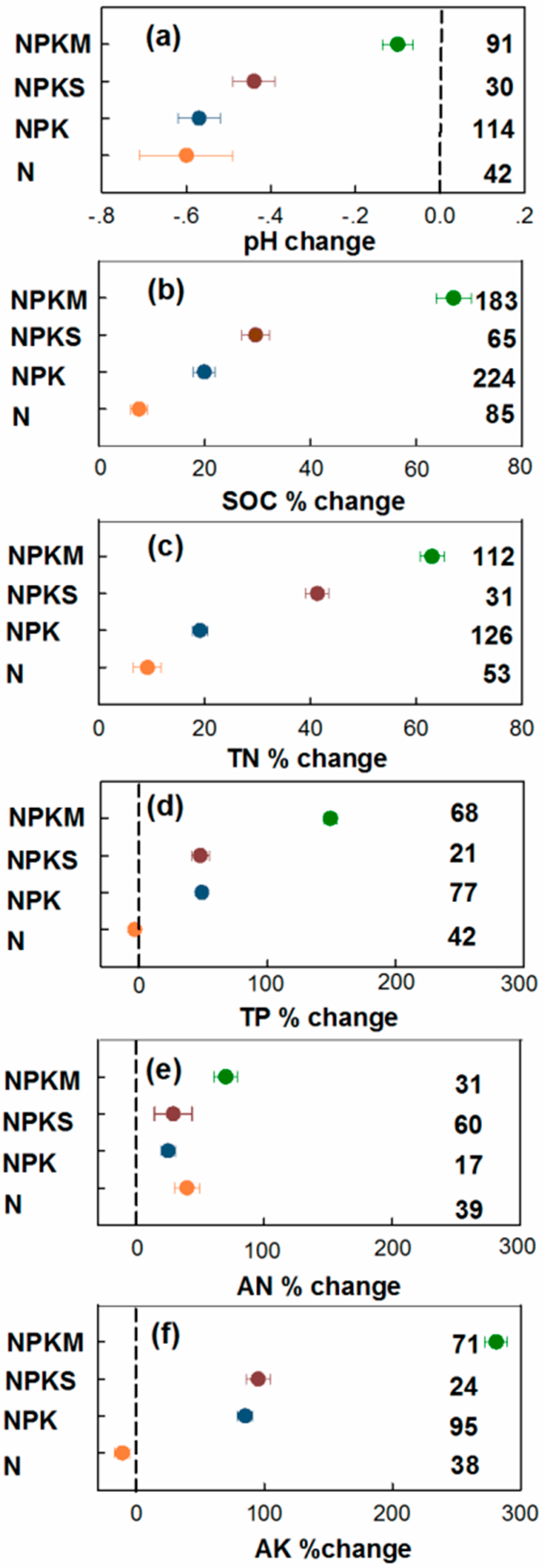
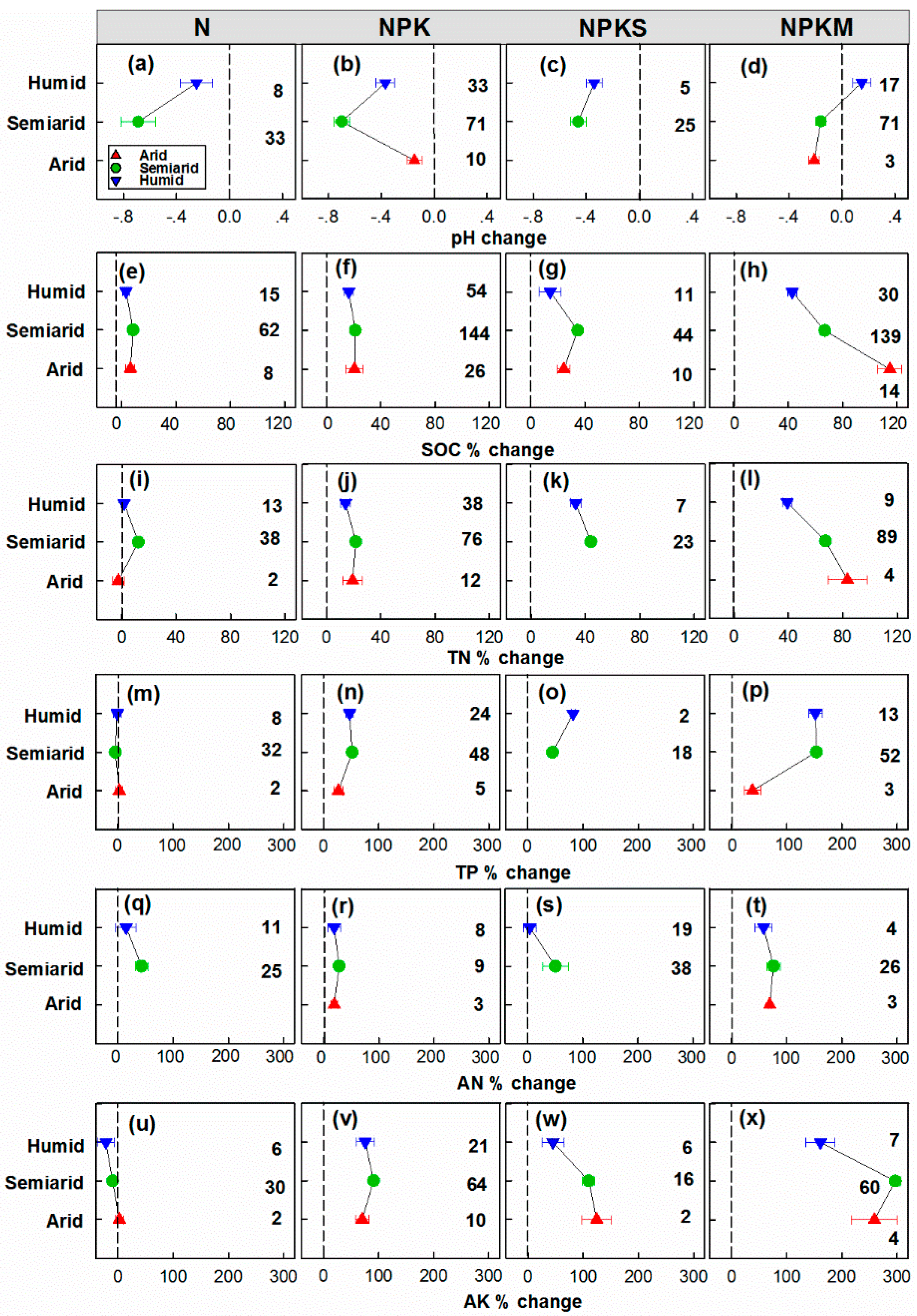
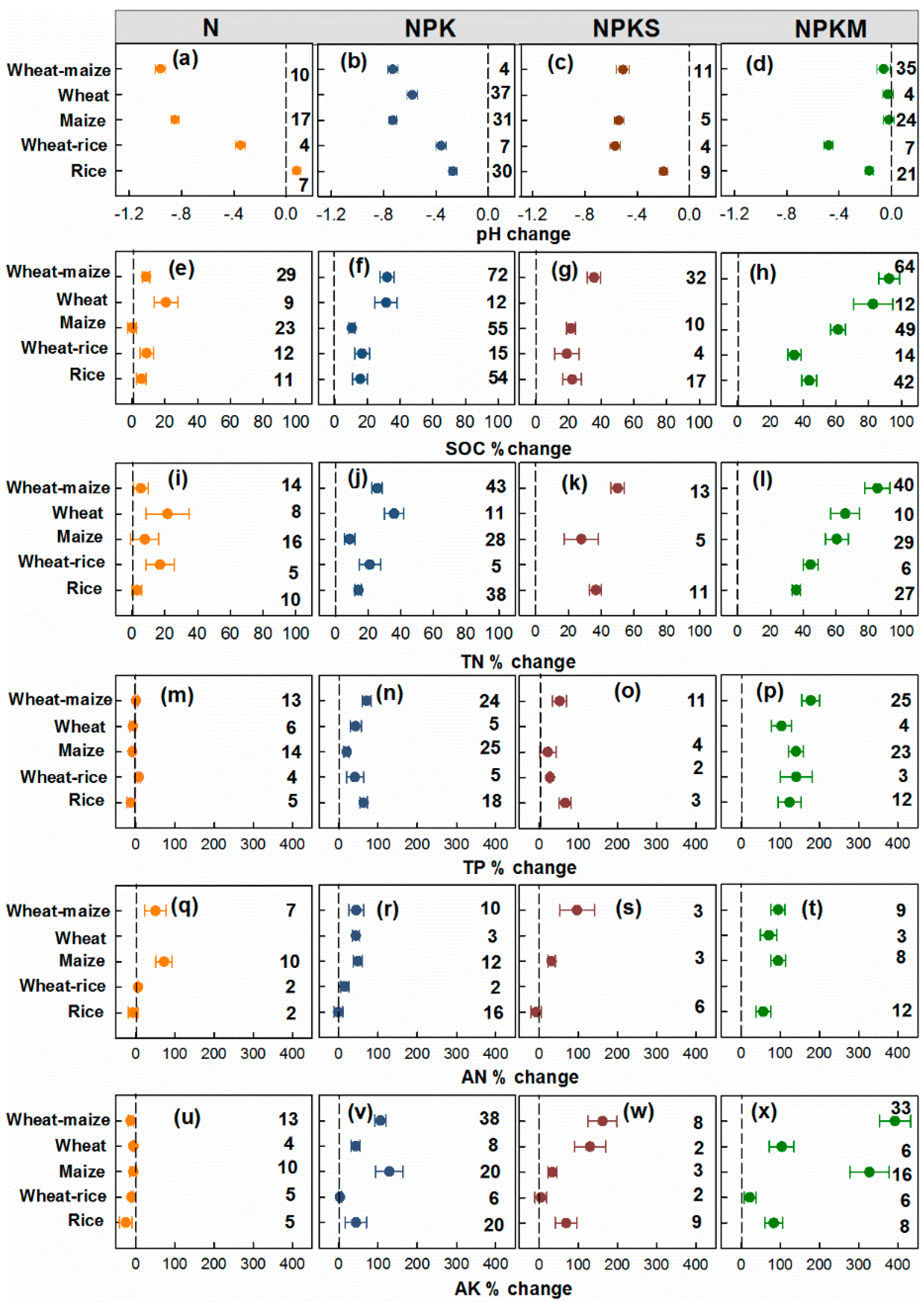
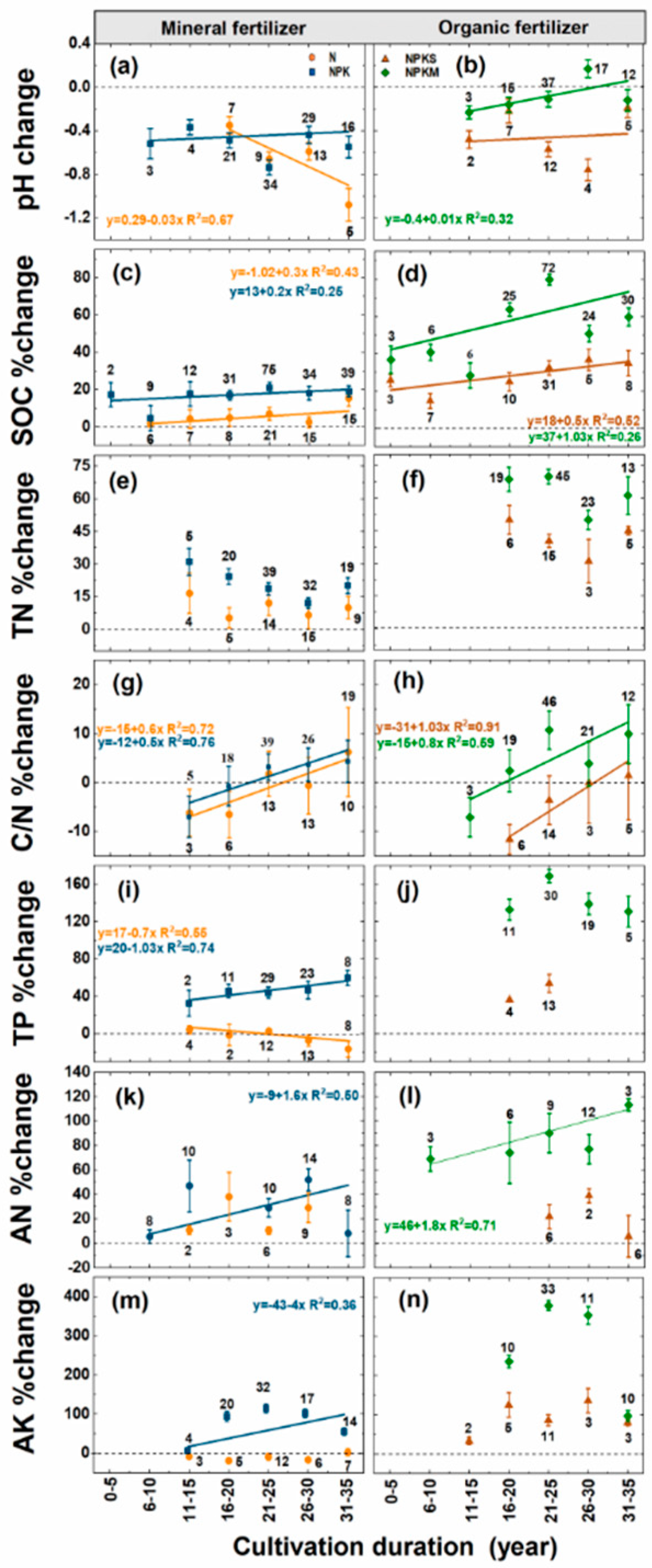
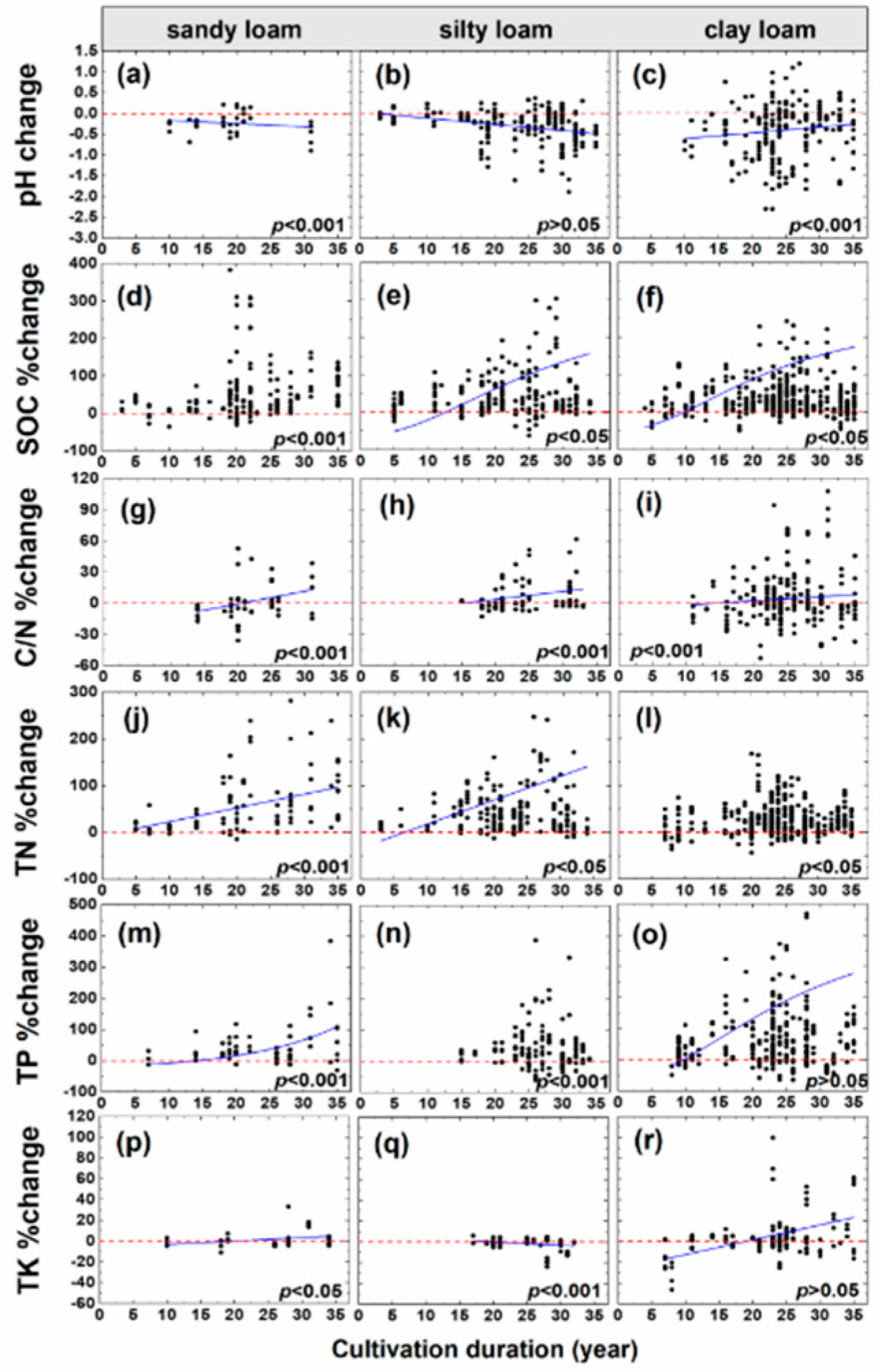
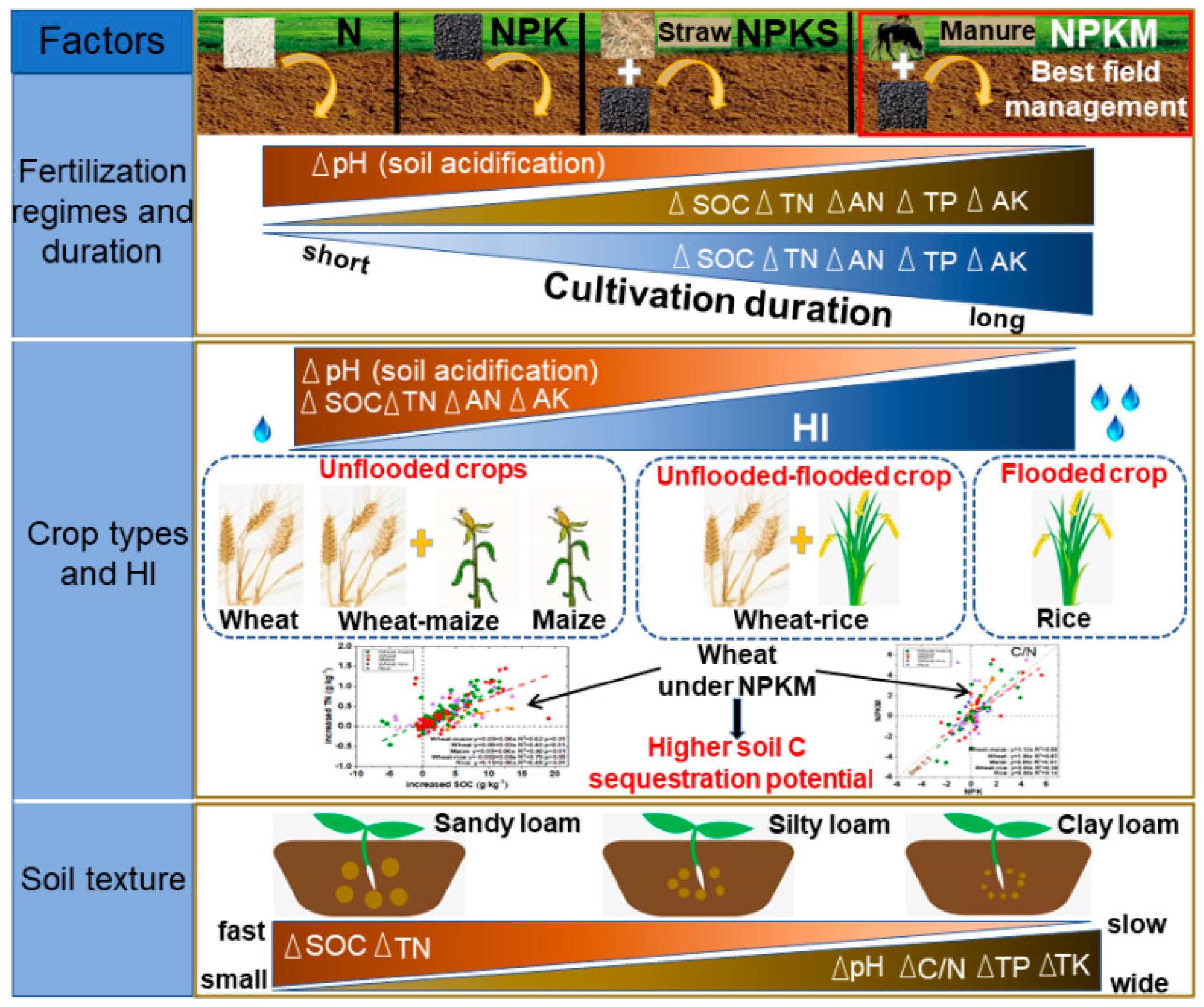
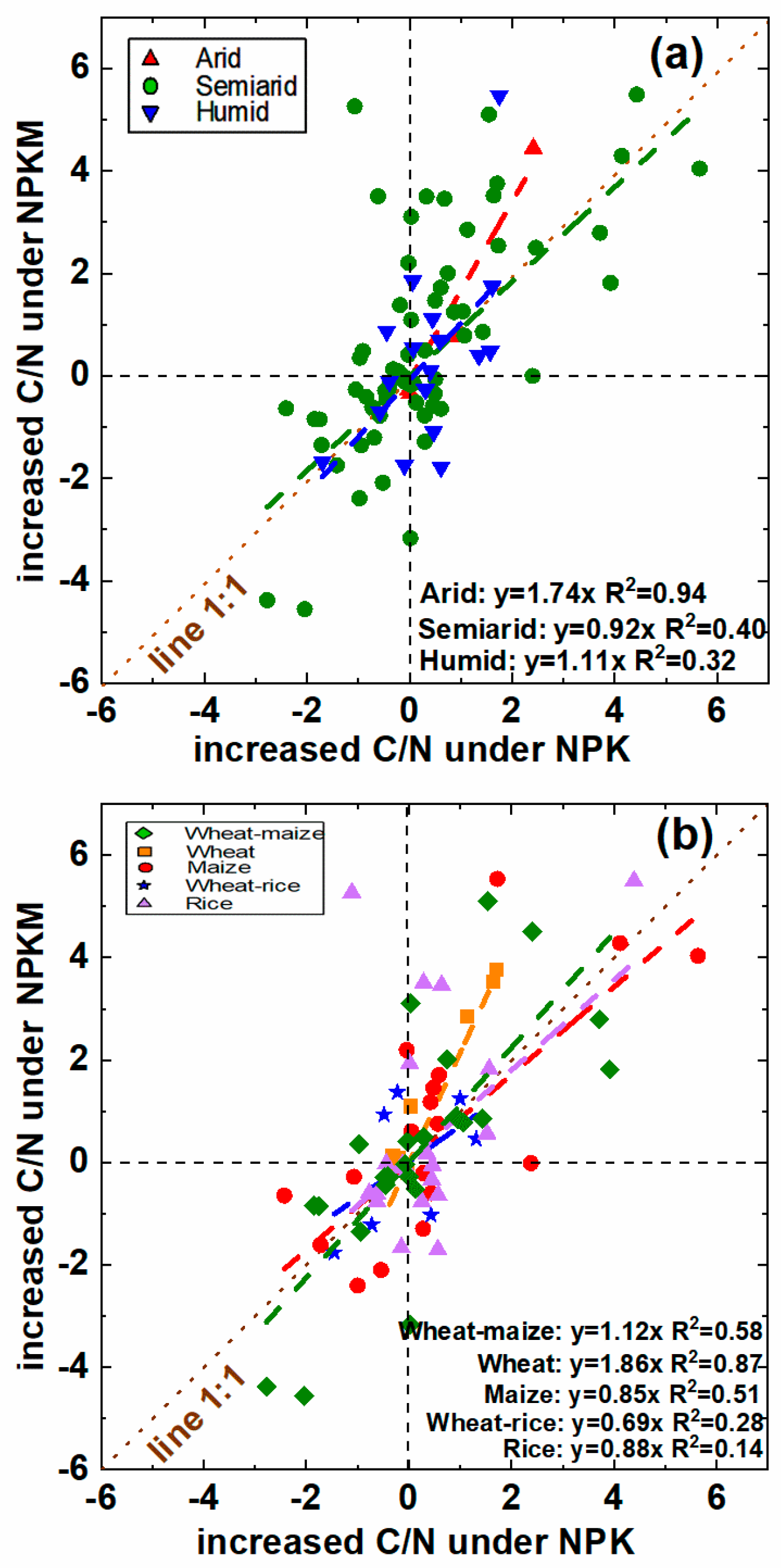
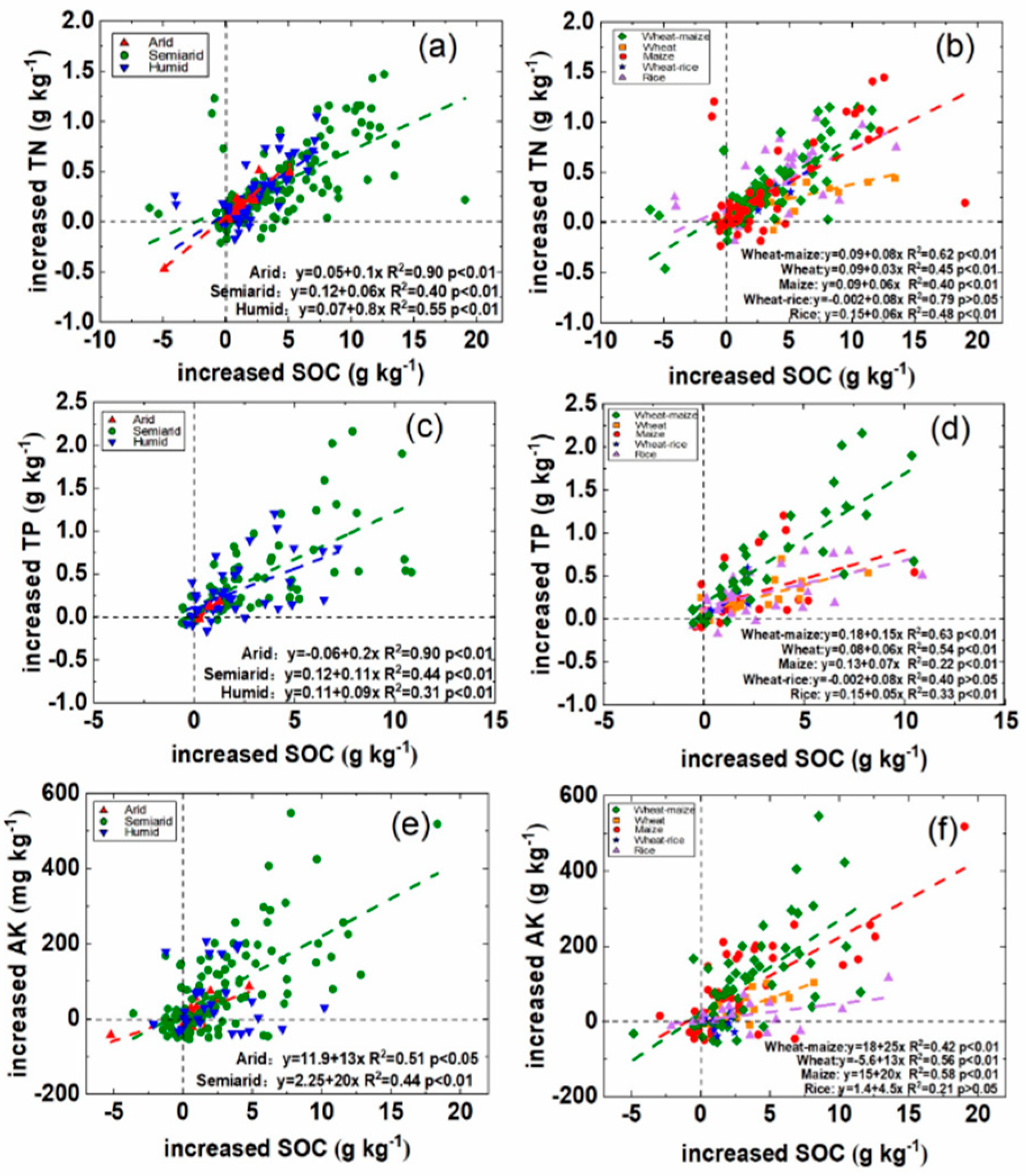
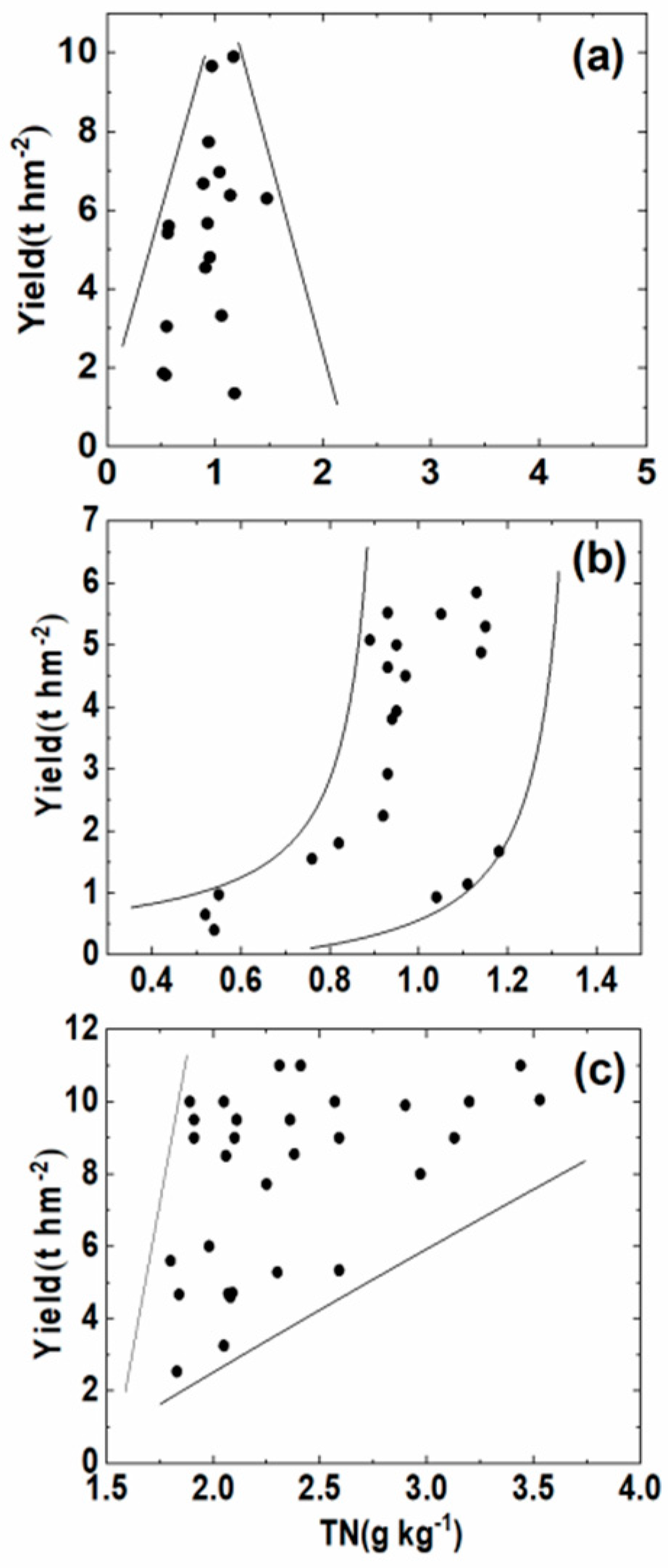
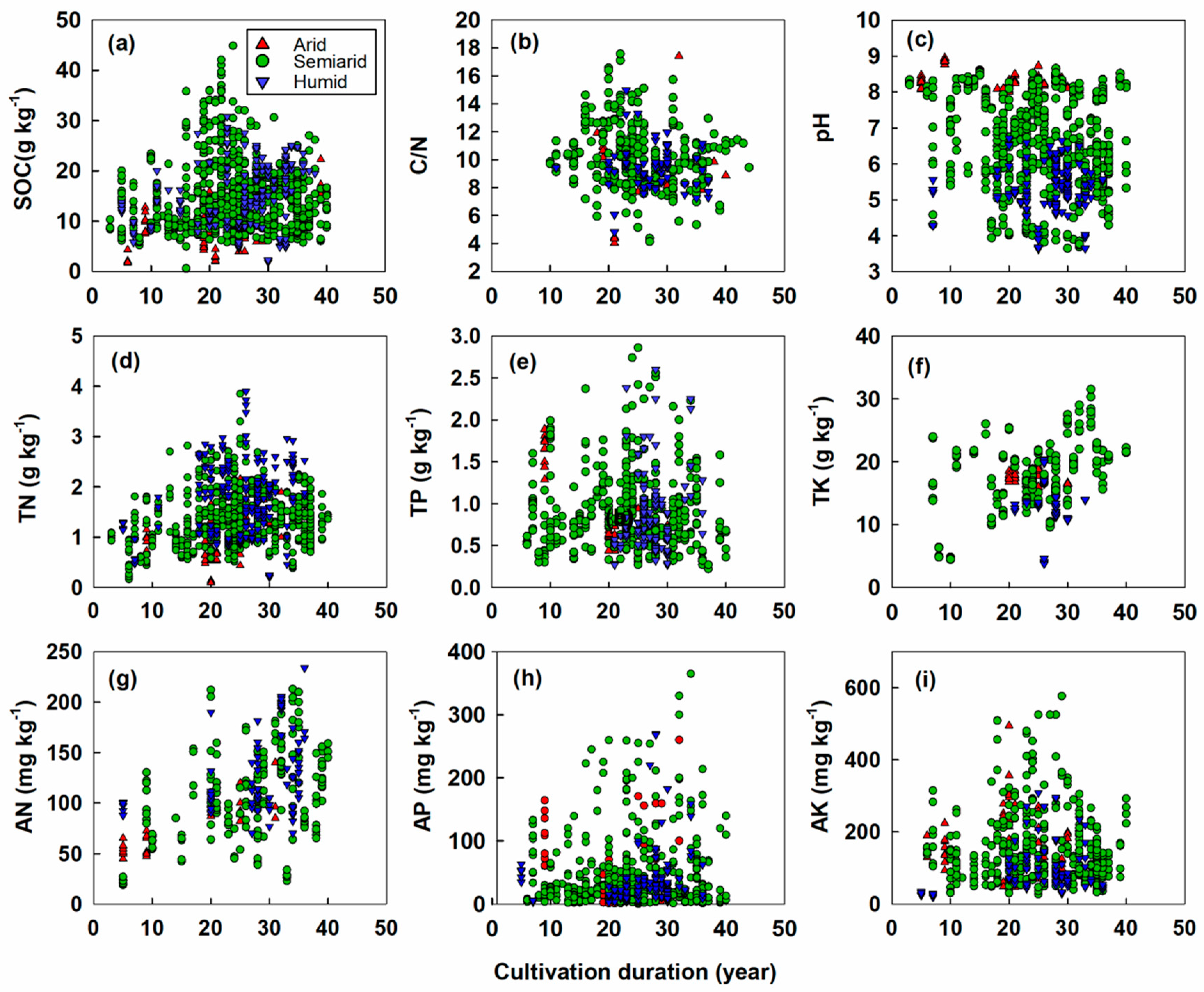
| Soil Properties | Explanatory Variables | ||||||||||||
|---|---|---|---|---|---|---|---|---|---|---|---|---|---|
| pH | SOC | TN | C/N | TP | TK | AN | AP | AK | MAT | MAP | Duration | HI | |
| pH | 0.18 ** 290 | 0.13 * 220 | 0.16 * 116 | 0.31 ** 14 | 0.29 ** 151 | 0.15 ** 343 | |||||||
| SOC | 0.70 ** 212 | 0.33 ** 220 | 0.71 ** 107 | 0.28 ** 99 | 0.47 ** 125 | 0.54 ** 147 | 0.07 * 687 | −0.11 ** 687 | 0.08 * 687 | −0.17 ** 687 | |||
| TN | −0.27 ** 211 | 0.55 ** 113 | 0.23 * 93 | 0.25 * 87 | 0.43 ** 122 | 0.43 ** 73 | −0.13 ** 400 | −0.20 ** 400 | |||||
| C/N | 0.23 * 90 | 0.24 * 114 | 0.28 ** 120 | 0.13 * 402 | |||||||||
| TP | 0.45 ** 66 | 0.73 ** 79 | 0.63 ** 84 | 0.23 ** 269 | 0.25 ** 269 | −0.15 * 269 | 0.20 ** 269 | ||||||
| TK | 0.51 ** 77 | ||||||||||||
| AN | 0.64 ** 88 | ||||||||||||
| AP | 0.53 ** 150 | ||||||||||||
| AK | 0.13 * 291 | ||||||||||||
| MAT | 0.80 ** 69 | 0.52 ** 69 | |||||||||||
| MAP | 0.89 ** 69 | ||||||||||||
| Duration | |||||||||||||
| HI | |||||||||||||
| Explanatory Variables | Variation Explained (%) | ||||
|---|---|---|---|---|---|
| pH | SOC | TN | TP | TK | |
| Fertilizers | 15 | 23 | 22 | 41 | 15 |
| HI | 12 | 9 | 9 | 10 | 4 |
| Crop types | 21 | 36 | 37 | 12 | 25 |
| Cultivation duration | 33 | 23 | 27 | 34 | 47 |
| Soil texture | 19 | 9 | 5 | 3 | 9 |
Publisher’s Note: MDPI stays neutral with regard to jurisdictional claims in published maps and institutional affiliations. |
© 2022 by the authors. Licensee MDPI, Basel, Switzerland. This article is an open access article distributed under the terms and conditions of the Creative Commons Attribution (CC BY) license (https://creativecommons.org/licenses/by/4.0/).
Share and Cite
Jia, S.; Yuan, D.; Li, W.; He, W.; Raza, S.; Kuzyakov, Y.; Zamanian, K.; Zhao, X. Soil Chemical Properties Depending on Fertilization and Management in China: A Meta-Analysis. Agronomy 2022, 12, 2501. https://doi.org/10.3390/agronomy12102501
Jia S, Yuan D, Li W, He W, Raza S, Kuzyakov Y, Zamanian K, Zhao X. Soil Chemical Properties Depending on Fertilization and Management in China: A Meta-Analysis. Agronomy. 2022; 12(10):2501. https://doi.org/10.3390/agronomy12102501
Chicago/Turabian StyleJia, Shengnan, Ding Yuan, Wenwen Li, Wei He, Sajjad Raza, Yakov Kuzyakov, Kazem Zamanian, and Xiaoning Zhao. 2022. "Soil Chemical Properties Depending on Fertilization and Management in China: A Meta-Analysis" Agronomy 12, no. 10: 2501. https://doi.org/10.3390/agronomy12102501
APA StyleJia, S., Yuan, D., Li, W., He, W., Raza, S., Kuzyakov, Y., Zamanian, K., & Zhao, X. (2022). Soil Chemical Properties Depending on Fertilization and Management in China: A Meta-Analysis. Agronomy, 12(10), 2501. https://doi.org/10.3390/agronomy12102501









